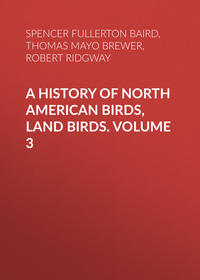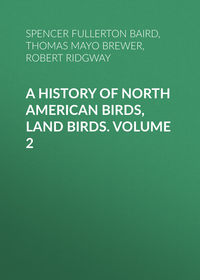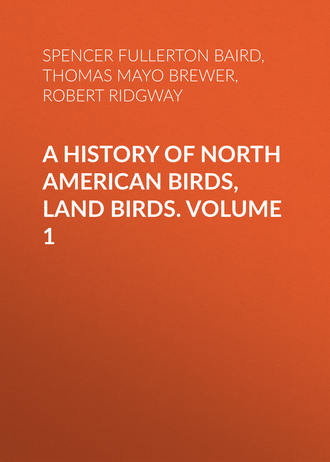 полная версия
полная версияA History of North American Birds, Land Birds. Volume 1
Hab. South Atlantic and Gulf States. Ohio! Kirtland.
Habits. The Brown-headed Nuthatch has a much more restricted distribution than the other members of this family in this country. The specimens in the Smithsonian Museum are chiefly from Georgia. Wilson met with it in Virginia, and states that it is found in the other Southern States. I have received its eggs from Cheraw, S. C., and from Florida.
Wilson’s description of its habits makes them almost identical with those of Sitta canadensis, while its notes are more shrill and chirping. Like that bird, it is very fond of the seeds of the pines. Wherever found, it is a constant resident, and does not migrate.
Audubon states that this bird never goes farther north than Maryland, and that it is the most abundant in Florida, Georgia, and the Carolinas. In Louisiana it is rare, and it is not found in Kentucky. Its notes, he states, are several octaves higher than those of the carolinensis, and more shrill, and at least an octave and a half higher than those of the canadensis.
Although apparently preferring pines and pine barrens, it by no means confines itself to them, but is not unfrequently seen on low trees and fences, mounting, descending, and turning in every direction, and with so much quickness of motion as to render it difficult to shoot it. It examines every hole and every crevice in the bark of trees, as well as their leaves and twigs, among which it finds abundance of food at all seasons. During the breeding-season they go about in pairs and are very noisy. Their only note is a monotonous cry, described as resembling dĕnd, dĕnd. Mr. Audubon further states that when the first brood leaves the nest, the young birds keep together, moving from tree to tree with all the activity of their parents, who join them when the second brood is able to keep them company. In Florida they pair in the beginning of February, having eggs as early as the middle of that month. In South Carolina they breed one month later. Their nest is usually excavated by the birds themselves in the dead portion of a low stump or sapling, sometimes only a few feet from the ground, but not unfrequently at the height of thirty or forty feet. Both birds are said to work in concert with great earnestness for several days, until the hole, which is round, and not larger at the entrance than the body of the bird, is dug ten or twelve inches deep, widening at the bottom. The eggs, according to Mr. Audubon, are laid on the bare wood. This, however, is probably not their constant habit. The eggs, from four to six in number, and not much larger than those of the Humming-Bird, have a white ground, thickly sprinkled with fine reddish-brown dots. They are said to raise two, and even three, broods in a season. According to the observations of the late Dr. Gerhardt of Northern Georgia, the Brown-headed Nuthatch breeds in that part of the country about the 19th of April.
The eggs of this Nuthatch are of a rounded oval shape, measuring .60 by .50 of an inch. Their white ground-color is so completely overlaid by a profusion of fine dottings of a dark purplish-brown as to be entirely concealed, and the egg appears almost as if a uniform chocolate or brown color.
Family CERTHIADÆ.—The Creepers
Char. Primaries ten; first very short; less than half the second. Tail long, wedge-shaped, the feathers stiffened and acute. Bill slender, much compressed and curved. Outer lateral toe much longest; hind toe exceeding both the middle toe and the tarsus, which is scutellate anteriorly and very short. Entire basal joint of middle toe united to the lateral.
Genus CERTHIA, LinnCerthia, Linnæus, Syst. Nat. ed. 10th, 1758, 112. (Type, C. familiaris.) (See Reichenbach, Handbuch, I, II, 1853, 256, for a monograph of the genus.)
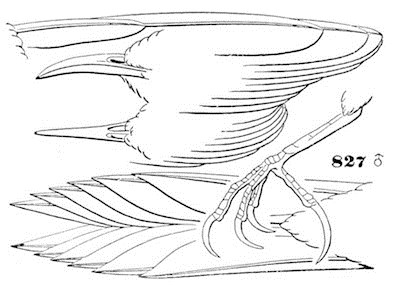
Certhia americana.
827 ♂
Gen. Char. Plumage soft and loose. Bill as long as head, not notched, compressed; all its lateral outlines decurved. Nostrils not overhung by feathers, linear, with an incumbent thickened scale, as in Troglodytes. No rictal bristles, and the loral and frontal feathers smooth, without bristly shafts. Tarsus scutellate anteriorly, shorter than middle toe, which again is shorter than hind toe. All claws very long, much curved and compressed; outer lateral toe much the longer; basal joint of middle toe entirely adherent to adjacent ones. Wings rather pointed, about equal to the tail, the feathers of which are much pointed, with stiffened shafts. Primaries ten; first less than half the second. Nest in holes of trees; eggs white, sprinkled with reddish.
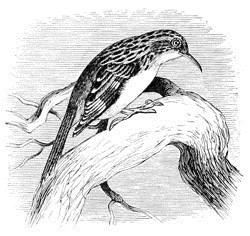
Certhia americana.
Of the Certhiadæ but one genus belongs to America,—Certhia, with its one small species of considerable variability with locality. The characters above given include both family and generic characters, derived from this one genus. This is readily distinguished by the decurved, compressed bill; absence of notch and bristles; exposed linear nostrils with incumbent scales; connate middle toe, very long claws, short tarsi, pointed and stiffened tail-feathers, etc.
The American and European varieties (they can scarcely be called species) resemble each other very closely, though they appear to be distinguished by such differences as the following:—
The two European races, C. familiaris and C. costæ, both differ from all the American varieties in having the crissum scarcely tinged with yellowish. C. familiaris is more ashy beneath than any others, and C. costæ is purest white beneath of all. Nearest C. familiaris, in the American series, as regards tints of the upper parts, are the Pacific coast specimens of C. americana,—while the latter are most like the Atlantic region specimens of the same. C. mexicana is to be compared only with the North American forms, though it is the only one approaching familiaris in the ashy lower parts.
C. familiaris is at once separated from the rest by having the tail shorter than the wing.
C. costæ is almost precisely like Eastern specimens of C. americana in colors, but is absolutely pure white below, and without the distinctly yellowish crissum of the American bird. The bill and claws, however, are considerably longer than in Eastern americana, though their size is almost equalled by those of Western specimens; the colors are, however, more decidedly different.
There is never any deviation from the generic pattern of coloration; but the variation, among individuals of each form, in length of the bill and claws, as well as the tail, is remarkable.
Certhia familiaris, var. americana, BonapBROWN CREEPERCerthia fusca, Barton, Fragments of the Natural History of Pennsylvania, 1799, II. Certhia familiaris, Vieill. Ois. Am. Sept. II, 1807, 70 (not the European bird); also of Wilson and Audubon.—Maynard, Birds E. Mass. 1870, 93. Certhia americana, Bonap. Comp. List. 1838.—Reich. Handb. I, 1853, 265, pl. dcxv, figs. 4102, 4103.—Baird, Birds N. Am. 1858, 372; Review, 89.—Max. Cab. Jour. 1858, 105.—Cooper & Suckley, P. R. R. Rep. XII, II, 1859, 192.—Hamlin, Pr. Bost. Soc. N. H. 1864—66, 80. Certhia mexicana, Cooper, Orn. Cal. 1, 1870, 58.
Sp. Char. Bill about the length of the head. Above dark brown, with a slightly rufous shade, each feather streaked centrally, but not abruptly, with whitish; rump rusty. Beneath almost silky-white; the under tail-coverts with a faint rusty tinge. A white streak over the eye; the ear-coverts streaked with whitish. Tail-feathers brown centrally, the edges paler yellowish-brown. Wings with a transverse bar of pale reddish-white across both webs. Length, 5.50; wing, 2.60; tail, 2.90. (No. 827.)
Young. (5945, Steilacoom, W. T.; Dr. J. S. Cooper.) Resembling the adult, but streaks above indistinct, and the feathers there tipped indistinctly with blackish; the rufous restricted to the upper tail-coverts. Breast and jugulum with very minute blackish wavings or indistinct bars.
Hab. Whole of United States, to Red River Settlement.
Specimens from the far west are purer white beneath, much as in costæ, but those from the northwest coast have the white tinged with light rusty. Though purer white below, these specimens are much browner above than Eastern ones,—sometimes more so than in familiaris, but then there is the yellowish crissum never seen in this “species,” and the proportions are quite different. Thus it will be seen the C. americana may always be distinguished from the other forms; when most resembling costæ in the grayish tints of the upper plumage (as in Eastern examples), the lower parts are less purely white, and the bill and claws smaller; when like it in the proportions and pure white of the lower parts (as in Western specimens), the colors above are altogether more brown. The yellowish crissum of americanus will also distinguish them. Though often resembling familiaris in the colors of the upper parts, the latter may always be distinguished by its ashy lower parts without yellowish crissum, the shorter tail, with its less acute feathers, and stouter bill.
C. mexicanus is still more different in colors, for which see that variety.
Habits. Our common Creeper, so closely resembling the Creeper of Europe as by many to be supposed identical with it, is distributed over the whole of North America, from the Gulf of Mexico to high northern latitudes. At different seasons it may be found in every one of the several States and Territories, yet it is never very abundant. The Smithsonian possesses specimens from various parts of the country, from Georgia to Fort Steilacoom on the Pacific, but of these none appear to have been secured during the period of reproduction. Dr. Heermann found them very common in the more mountainous districts of California. Dr. Cooper found these birds abundant in the forests of Washington Territory, but difficult to detect from the similarity of their color to that of the bark over which they crept. They were apparently constant residents in that Territory. Dr. Suckley, who obtained several specimens of this species in the oak groves in the vicinity of Fort Steilacoom, states that in their habits the Western birds resemble those of the Atlantic States.
Mr. Ridgway found this Creeper inhabiting both the pine forests of the Sierra Nevada, where it was the more common, and also, in winter, among the willows of the river valleys. He did not meet with it east of the Truckee River, nor until he had reached the Wahsatch Mountains.
Dr. Woodhouse found the Brown Creeper generally distributed throughout the Indian Territory, Texas, New Mexico, and California, and adds that it was especially abundant in the San Francisco Mountains of New Mexico.
Dr. Cooper states that he has met with this form in the winter throughout the higher mountains and among the Coast Range as far south as Santa Cruz. He found them chiefly frequenting the coniferous trees, creeping up and down their trunks and branches, searching for insects in their crevices, and so nearly resembling the bark in their general color, that they can be detected only with great difficulty, except when in motion.
He adds that their notes are shrill and wiry, and are often heard when the bird is scarcely visible, without a careful search, their cry appearing to be from a greater distance than the real performer. In March, Dr. Cooper heard them giving out a faint but sharp-toned song, resembling that of a Wren. If Dr. Cooper is correct in his account of the notes, they do not correspond with those of our Eastern bird.
Dr. Kennerly, in his Report on the birds observed by him near the 35th parallel, states that he found our common Creeper very abundant among the rough-barked cedars in the Aztec Mountains. It usually attracted notice, and its place of retreat was discovered, by his hearing its quick and sharp notes. A close and careful search generally enabled him to perceive it proceeding leisurely upward and downward, in straight or spiral lines, toward the top of the tree, dodging dexterously to the opposite side from the observer, and only resuming its occupation when assured of solitude and safety.
The observations of Dr. Kennerly, if they are to be received as characteristic of the Western Creepers, do not correspond with those of our Eastern birds, as far as we have observed them. None of our birds are more easily approached, and when they are pursuing their search for food, none are more regardless of observation. The statement that our Creeper, when watched, moves to the opposite side of the tree from the looker-on, has found a certain currency in our books. We are, however, of the opinion that this is owing to its restless activity, prompting it to constant changes of place and position, and not to its timidity or caution. We have uniformly found them either unconscious or regardless of our near presence.
They are solitary in their habits, and frequent, especially in the summer, deep woods, searching for their favorite food in high places where it is difficult to reach them, but this is no necessary evidence of their shyness. They often hunt for their food in very exposed places, with equal courage and recklessness. It is an active, restless bird, associating with Titmice and the smaller Woodpeckers, moving with great rapidity from side to side and from place to place. They breed in hollow trees, in the deserted holes of the Woodpeckers, and in the decayed stumps and branches of trees. Their nest is a loose aggregation of soft, warm materials, not interwoven, but simply collected with regard to no other requisite than warmth.
In the summer of 1851 our party, in their visit to one of the smaller Grand Menan Islands, was so fortunate as to meet with the nest of this bird. It was built in a decayed birch-tree, only a few feet from the ground, and contained five eggs nearly ready to hatch. This was on the 20th of June. The nest was an intermingling of decayed wood, the fur of small quadrupeds, and feathers, but with so little adherence or consistency of form that it was impossible to retain the materials in position after removal.
So far from evincing any timidity, the birds refused to leave their nest, and could hardly be prevented from following it when removed from the woods to a house on the island. One of our companions, returning to the woods in order to secure the birds for the sake of identification, found the pair still lingering round the place of their rifled nest. Upon his approach they began to circle round his head with reproachful cries, and continued to keep so close to him that it was impossible to shoot one without mutilating it. At length one of the birds alighted on a small branch held over his head by a lad who accompanied him, and in this position was secured by shooting it with a pistol loaded with the finest shot. Its mate could have been secured, as she persisted in pursuing them, but she was not molested. Throughout there was not a trace of timidity on the part of either bird, but the most reckless and daring devotion.
Besides the single call-note or the sharp outcry with which the Creepers signalize their movements, and which they utter from time to time as they rapidly and busily move up and down the trunks and limbs, or flit from tree to tree, they have been generally regarded as having no song. But this is not the fact. The careful observations of Mr. William Brewster of Cambridge have satisfied him that these birds have a very distinct and varied song. During the winter these birds are not uncommon in the vicinity of Boston, coming about the houses with all the tameness and confidence of the Parus atricapillus, and permit a very near approach. They are very easily attracted by suspending from a piazza a piece of fat meat. Mr. Brewster has observed them commence singing as early as the 14th of March. Their notes are varied and warbling and somewhat confused; some of them are loud, powerful, and surpassingly sweet, others are more feeble and plaintive; their song usually ends with their accustomed cry, which may be represented by crēē-crēē-crē-ēp. Mr. Brewster, besides repeatedly hearing them sing in Massachusetts in the early spring, has also listened to their song in Maine in the month of June.
Their eggs are small in proportion to the size of the bird, are nearly oval in shape, with a grayish-white ground, sparingly sprinkled with small, fine, red and reddish-brown spots. They measure .55 by .43 of an inch.
Certhia familiaris, var. mexicana, GlogMEXICAN CREEPERCerthia mexicana, “Gloger, Handbuch,” Reichenbach, Handbuch, I, 1853, 265, pl. dlxii, figs. 3841, 3842.—Sclater, P. Z. S. 1856, 290; 1858, 297; 1859, 362, 372.—Salvin, Ibis, 1866, 190 (Volcan de Fuego, Guat.).—Baird, Birds N. Am. 1858, 373 (under C. americana), pl. lxxxiii, fig. 2; Review, 90.
Sp. Char. Ground-color above very dark sepia-brown, each feather with a sharply defined medial streak of grayish-white, these streaks becoming broader posteriorly, where they are discontinued at the beginning of the rump. Whole rump and upper tail-coverts chestnut-rufous. Beneath pale ashy, becoming almost white on the throat; crissal feathers deep ochraceous except at the tips, which are whitish. Markings of the wings as usual. Measurements (8176, Mexico): wing, 2.50; tail, 2.70; bill (from nostril), .48; hind claw, .30.
Hab. Guatemala and Mexico; probably extending along the table-lands into the United States.
This is one of the best marked of the various races that have been discussed (see p. 124). The ground-color of the upper parts is altogether darker than in any of the others, and the streaks are more sharply defined and narrower; the rufous of the rump is of a castaneous, instead of yellowish cast; the wings appear more uniform with the back, owing to the dark color of the latter, and their pale markings have little of that yellowish tinge so noticeable in the others. In the ashy tinge of the lower parts there is a resemblance to familiaris of Europe; but the latter has not the ochraceous crissum so noticeable in the present bird. There is little resemblance to Western and Rocky Mountain specimens of the C. americana and if these are to be considered as separable from the Eastern (which, however, would not, in our opinion, be advisable) they must not be referred to mexicana.
The Mexican Creeper is introduced here on account of the probability of its occurrence in the Southern Rocky Mountains.
Habits. Mr. Salvin found the Mexican Tree-Creeper by no means uncommon in the pine forests of the upper zone of the Volcan de Fuego. He also observed it frequenting pine-trees in the district of Chilasco, Vera Paz, at about 6,000 feet above the sea.
Family TROGLODYTIDÆ.—The Wrens
Char. Rictal bristles wanting; the loral feathers with bristly points; the frontal feathers generally not reaching to nostrils. Nostrils varied, exposed or not covered by feathers, and generally overhung by a scale-like membrane. Bill usually without notch (except in some Middle American genera). Wings much rounded, about equal to tail, which is graduated. Primaries ten, the first generally about half the second. Basal joint of middle toe usually united to half the basal joint of inner, and the whole of that of the outer, or more. Lateral toes about equal, or the outer a little the longer. Tarsi scutellate.
The impossibility of defining any large group of animals, so as to separate it stringently and abruptly from all others, is well understood among naturalists; and the Troglodytidæ form no exception to the rule. Some bear so close a resemblance to the Mocking Thrushes as to have been combined with them; while others again exhibit a close approximation to other subfamilies. The general affinities of the family, however, appear to be to the Turdidæ, and one of the best characters for separating the two families appears to exist in the structure of the feet.
In the Turdidæ the basal joint of the outer lateral toe is united to the middle toe, sometimes only a part of it; and the inner toe is cleft almost to its very base, so as to be opposable to the hind toe, separate from the others. In the Troglodytidæ, on the contrary, the inner toe is united by half its basal joint to the middle toe, sometimes by the whole of this joint; and the second joint of the outer toe enters wholly or partially into this union, instead of the basal joint only. In addition to this character, the open, exposed nostrils, the usually lengthened bill, the generally equal lateral toes, the short rounded wings, the graduated tail, etc., furnish points of distinction.
Genera.
A. Lateral toes very unequal.
a. Culmen depressed basally, the interval between the nostrils wider than the much compressed anterior half of the bill. Plate on the posterior half of the tarsus continuous. Catherpes.
b. Culmen compressed basally, the interval between the nostrils narrower than the rather depressed anterior half of the bill. Plate on the posterior half of the tarsus broken into smaller scales. Salpinctes.
B. Lateral toes equal.
c. Length about 8 inches. Campylorhynchus.
d. Length less than 6 inches.
Bill abruptly decurved or hooked at the tip. Outstretched feet not reaching near to end of tail. Thryothorus.
Tail longer than the wing, the feathers black, variegated terminally with whitish … Subgenus Thryomanes.
Tail shorter than the wing, the feathers rusty, not variegated with whitish … Subgenus Thryothorus.
Bill only gently curved at the tip. Outstretched feet reaching nearly to or beyond the end of the tail.
Back without streaks. No distinct superciliary stripe. Troglodytes.
Bill curved, sub-conical. Tail as long as wing … Subgenus Troglodytes.
Bill straight, subulate. Tail much shorter than wing … Subgenus Anorthura.
Back streaked with black and white. Cistothorus.
Bill short, stout; its depth equal to one half its length from the nostril; gonys straight or even convex, ascending. Crown streaked; no distinct superciliary stripe … Subgenus Cistothorus.
Bill elongated, slender; its depth less than one third its length from the nostril; gonys slightly concave, declining. Crown not streaked; a conspicuous superciliary stripe … Subgenus Telmatodytes.
Genus CAMPYLORHYNCHUS, SpixCampylorhynchus, Spix, Av. Bras. I, 1824, 77. (Type, C. scolopaceus, Spix = Turdus variegatus, Gmel.)
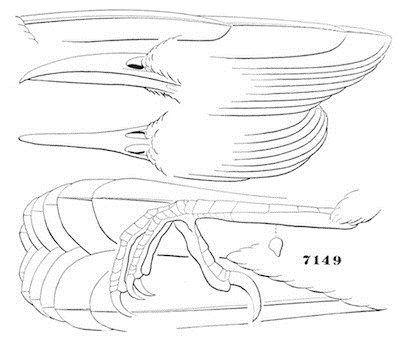
Campylorhynchus brunneicapillus.
7149
Gen. Char. Bill stout, compressed, as long as, or longer than the head, without notch or rictal bristles; culmen and commissure curved; gonys nearly straight. Nostrils in the antero-inferior part of nasal groove, in advance of the frontal feathers, with an overhanging scale with thickened edge, as in Thryothorus; sometimes, as in the type, reduced to a slight ridge along the upper side of the nasal groove. Lateral septum not projecting below or anteriorly into the nasal cavity, but concealed by the nasal scale. Tarsus a little longer than middle toe and claw; claws strong, much curved, and very sharp; middle toe with basal joint adherent almost throughout. Wings and tail about equal, the latter graduated; the exterior webs of lateral feathers broad.
This genus embraces the largest species of the family, and is well represented in Middle and South America, two species only reaching into North America, which may be distinguished as follows:—
Top of head and post-ocular stripe reddish-brown; back streaked longitudinally and linearly with white. All the feathers beneath conspicuously spotted. Crissum and flanks with rounded or elongated spots. Iris reddish. Nostrils inferior, linear, overhung by a scale. Nests large and purse-shaped; eggs white, profusely marked with salmon-colored or reddish spots.




